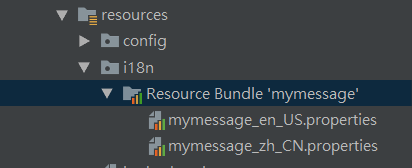正文
1、
通过util包中的ResourceBundle加载:
首先国际化资源文件放在了classpath下的i18n目录下:

mymessage_en_US.properties:
com.website.operation=u67e5u8be2u64cdu4f5cu65e5u5fd7
com.website.write=u5199u65e5u5fd7
com.website.writeLog=u5199 {0} u65e5u5fd7
mymessage_en_US.properties:
com.website.operation=queryOperationLog
com.website.write=recordLog
com.website.writeLog=record {0} Log
利用ResourceBundle加载国际化文件,这里列出四个方法,分别是利用默认Locale、zh_CN、en_US以及带占位符的处理方式。这里需要注意的是BaseName为classpath下的目录+/+国际化文件名前缀,即i18n/mymessage
package com.website.controller.utils;
import java.text.MessageFormat;
import java.util.Locale;
import java.util.ResourceBundle;
/**
* @program: website
* @description: 获取国际化配置文件
* @author: smallsoup
* @create: 2018-07-27 22:32
**/
public class ResourceUtils {
public static String getEnglishValueByKey(String key){
Locale locale = new Locale("en", "US");
//使用指定的英文Locale
ResourceBundle mySource = ResourceBundle.getBundle("i18n/mymessage", locale);
return mySource.getString(key);
}
public static String getChineseValueByKey(String key){
Locale locale = new Locale("zh", "CN");
//使用指定的中文Locale
ResourceBundle mySource = ResourceBundle.getBundle("i18n/mymessage", locale);
return mySource.getString(key);
}
public static String getDeafultValueByKey(String key){
//使用默认的Locale
ResourceBundle mySource = ResourceBundle.getBundle("i18n/mymessage");
return mySource.getString(key);
}
public static String getValueAndPlaceholder(String key){
//使用默认的Locale
ResourceBundle mySource = ResourceBundle.getBundle("i18n/mymessage");
String beforeValue = mySource.getString(key);
//填充国家化文件中的占位符
String afterValue = MessageFormat.format(beforeValue, "安全");
return afterValue;
}
}
在controller里面调用ResourceUtils里的方法:
@RequestMapping(value = "/projectadd")
public String projectAdd(){
LOGGER.warn("projectAdd getChineseValueByKey is {}", ResourceUtils.getChineseValueByKey("com.website.operation"));
LOGGER.warn("projectAdd getDeafultValueByKey is {}", ResourceUtils.getDeafultValueByKey("com.website.operation"));
LOGGER.warn("projectAdd getEnglishValueByKey is {}", ResourceUtils.getEnglishValueByKey("com.website.operation"));
LOGGER.warn("projectAdd getValueAndPlaceholder is {}", ResourceUtils.getValueAndPlaceholder("com.website.writeLog"));
return "project/projectadd";
}
启动tomcat打印日志:

2、
利用spring的ResourceBundleMessageSource
ResourceBundleMessageSource是基于JDK ResourceBundle的MessageSource接口实现类。它会将访问过的ResourceBundle缓存起来,以便于下次直接从缓存中获取进行使用。
和上面不同的是ResourceUtils的实现,实现如下:
package com.website.controller.utils;
import org.springframework.context.support.ResourceBundleMessageSource;
import java.util.Locale;
/**
* @program: website
* @description: 获取国际化配置文件
* @author: smallsoup
* @create: 2018-07-27 22:32
**/
public class ResourceUtils {
private static ResourceBundleMessageSource messageSource = new ResourceBundleMessageSource();
static {
//指定国家化资源文件路径
messageSource.setBasename("i18n/mymessage");
//指定将用来加载对应资源文件时使用的编码,默认为空,表示将使用默认的编码进行获取。
messageSource.setDefaultEncoding("UTF-8");
}
public static String getChineseValueByKey(String key){
return messageSource.getMessage(key, null, Locale.CHINA);
}
public static String getDeafultValueByKey(String key){
return messageSource.getMessage(key, null, null);
}
public static String getEnglishValueByKey(String key){
return messageSource.getMessage(key, null, Locale.US);
}
public static String getValueAndPlaceholder(String key){
return messageSource.getMessage(key, new Object[]{"安全"}, null);
}
}
3、
利用spring的ReloadableResourceBundleMessageSource
ReloadableResourceBundleMessageSource也是MessageSource的一种实现,其用法配置等和ResourceBundleMessageSource基本一致。所不同的是ReloadableResourceBundleMessageSource内部是使用PropertiesPersister来加载对应的文件,这包括properties文件和xml文件,然后使用java.util.Properties来保存对应的数据。
package com.website.controller.utils;
import org.springframework.context.support.ReloadableResourceBundleMessageSource;
import java.util.Locale;
/**
* @program: website
* @description: 获取国际化配置文件
* @author: smallsoup
* @create: 2018-07-27 22:32
**/
public class ResourceUtils {
private static ReloadableResourceBundleMessageSource messageSource = new ReloadableResourceBundleMessageSource();
static {
//指定国家化资源文件路径
messageSource.setBasename("i18n/mymessage");
//指定将用来加载对应资源文件时使用的编码,默认为空,表示将使用默认的编码进行获取。
messageSource.setDefaultEncoding("UTF-8");
//是否允许并发刷新
messageSource.setConcurrentRefresh(true);
//ReloadableResourceBundleMessageSource也是支持缓存对应的资源文件的,默认的缓存时间为永久,即获取了一次资源文件后就将其缓存起来,以后再也不重新去获取该文件。这个可以通过setCacheSeconds()方法来指定对应的缓存时间,单位为秒
messageSource.setCacheSeconds(1200);
}
public static String getChineseValueByKey(String key){
return messageSource.getMessage(key, null, Locale.CHINA);
}
public static String getDeafultValueByKey(String key){
return messageSource.getMessage(key, null, null);
}
public static String getEnglishValueByKey(String key){
return messageSource.getMessage(key, null, Locale.US);
}
public static String getValueAndPlaceholder(String key){
return messageSource.getMessage(key, new Object[]{"安全"}, null);
}
}
这三种方式最后结果是一样的。
参考:
国际化MessageSource
http://elim.iteye.com/blog/2392583
本公众号免费提供csdn下载服务,海量IT学习资源,如果你准备入IT坑,励志成为优秀的程序猿,那么这些资源很适合你,包括但不限于java、go、python、springcloud、elk、嵌入式 、大数据、面试资料、前端 等资源。同时我们组建了一个技术交流群,里面有很多大佬,会不定时分享技术文章,如果你想来一起学习提高,可以公众号后台回复【2】,免费邀请加技术交流群互相学习提高,会不定期分享编程IT相关资源。
扫码关注,精彩内容第一时间推给你
